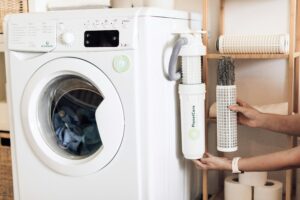[playht_player width=”100%” height=”90px” voice=”en-US-DavisNeural”]
Introduction
LG ovens have become increasingly popular in recent years due to their sleek design, advanced features, and reliable performance. These ovens are known for their durability and efficiency, making them a favorite among homeowners and professional chefs alike. However, like any appliance, LG ovens can experience problems from time to time. It is important to know how to troubleshoot these issues and properly maintain your oven to ensure it continues to function at its best.
Maintaining and troubleshooting your LG oven is crucial for several reasons. First, regular maintenance helps to prolong the lifespan of your oven and prevent costly repairs down the line. By keeping your oven clean and performing routine maintenance tasks, you can ensure that it operates efficiently and effectively. Additionally, knowing how to troubleshoot common problems can save you time and money by allowing you to fix minor issues on your own without the need for professional assistance.
Troubleshooting Common LG Oven Problems
While LG ovens are known for their reliability, they can still experience common issues that may require troubleshooting. One common problem is uneven cooking or baking, where one side of the food is cooked more than the other. This can be caused by a variety of factors, such as a faulty heating element or improper placement of the food in the oven. To troubleshoot this issue, start by checking the heating element for any signs of damage or wear. If the element appears to be in good condition, try rotating the food halfway through the cooking process to ensure even heat distribution.
Another common problem with LG ovens is a malfunctioning temperature sensor. This can cause the oven to overheat or underheat, resulting in unevenly cooked food or inaccurate temperature readings. To troubleshoot this issue, start by checking the temperature sensor for any signs of damage or corrosion. If the sensor appears to be in good condition, you may need to recalibrate it using the oven’s manual or contacting LG customer support for assistance.
To prevent future problems with your LG oven, there are a few tips you can follow. First, always preheat your oven before cooking or baking to ensure accurate temperature readings. This will help to prevent undercooked or overcooked food. Additionally, avoid slamming the oven door or using abrasive cleaners on the interior, as this can cause damage to the oven’s components. Finally, regularly clean the oven’s vents and filters to prevent the buildup of grease and debris, which can affect its performance.
Cleaning and Maintaining Your LG Oven
Regular cleaning and maintenance are essential for keeping your LG oven in top condition. Not only does this help to prevent issues such as uneven cooking or malfunctioning temperature sensors, but it also ensures that your oven operates efficiently and effectively.
To clean your LG oven, start by removing any racks or accessories and soaking them in warm, soapy water. While they are soaking, use a damp cloth or sponge to wipe down the interior of the oven, removing any food debris or spills. For stubborn stains or grease buildup, you can use a non-abrasive cleaner specifically designed for ovens. Be sure to follow the manufacturer’s instructions when using any cleaning products.
Once the interior is clean, rinse and dry the racks and accessories before placing them back in the oven. It is important to ensure that they are completely dry to prevent rusting or damage. Finally, wipe down the exterior of the oven with a damp cloth to remove any fingerprints or smudges.
In addition to regular cleaning, there are a few tips you can follow to maintain your LG oven’s performance. First, avoid using aluminum foil or other materials on the bottom of the oven, as this can interfere with heat distribution and cause damage to the heating element. Additionally, regularly check and replace the oven’s gasket if it appears worn or damaged. The gasket helps to create a seal between the oven door and the interior, preventing heat loss and ensuring even cooking.
Replacing LG Oven Parts: A DIY Guide
There may come a time when you need to replace parts in your LG oven. This could be due to wear and tear, damage, or malfunctioning components. While it is always recommended to consult a professional for complex repairs, there are some parts that you can replace yourself with the right tools and knowledge.
One common part that may need replacing is the heating element. Over time, the heating element can become worn or damaged, resulting in uneven cooking or a complete loss of heat. To replace the heating element, start by disconnecting the power to the oven. Then, remove the screws holding the element in place and carefully pull it out. Disconnect the wires from the old element and attach them to the new one before securing it back into place.
Another part that may need replacing is the temperature sensor. As mentioned earlier, a malfunctioning temperature sensor can cause inaccurate temperature readings and uneven cooking. To replace the temperature sensor, start by disconnecting the power to the oven. Then, locate the sensor inside the oven and remove any screws or clips holding it in place. Disconnect the wires from the old sensor and attach them to the new one before securing it back into place.
When replacing parts in your LG oven, it is important to ensure proper installation to prevent further damage or safety hazards. Always consult the oven’s manual or contact LG customer support for specific instructions on replacing parts. Additionally, be sure to disconnect the power to the oven before attempting any repairs and use caution when handling electrical components.
LG Oven Error Codes: What They Mean and How to Fix Them
LG ovens are equipped with error codes that can help diagnose and troubleshoot issues with your appliance. These error codes are displayed on the oven’s control panel and can indicate a variety of problems, from simple malfunctions to more serious issues.
One common error code is “F1,” which indicates a problem with the oven’s temperature sensor. This can be caused by a faulty sensor or a wiring issue. To troubleshoot this error code, start by checking the temperature sensor for any signs of damage or corrosion. If the sensor appears to be in good condition, you may need to replace it. If the sensor is functioning properly, check the wiring connections to ensure they are secure and not damaged.
Another common error code is “F3,” which indicates a problem with the oven’s temperature sensor circuit. This can be caused by a faulty sensor or a wiring issue. To troubleshoot this error code, start by checking the temperature sensor for any signs of damage or corrosion. If the sensor appears to be in good condition, you may need to replace it. If the sensor is functioning properly, check the wiring connections to ensure they are secure and not damaged.
To prevent future error codes, there are a few tips you can follow. First, always follow the manufacturer’s instructions when using your LG oven and avoid overloading it with heavy or oversized dishes. Additionally, avoid slamming the oven door or using excessive force when operating the control panel. Finally, regularly clean and maintain your oven as outlined in the previous section to prevent issues that can trigger error codes.
Upgrading Your LG Oven: New Features and Technology
If you are considering upgrading your LG oven, you will be pleased to know that there are many new features and technologies available that can enhance your cooking experience. From advanced cooking modes to smart home integration, these features can make cooking easier and more convenient.
One popular feature in newer LG ovens is convection cooking. Convection ovens use a fan to circulate hot air throughout the oven, resulting in faster and more even cooking. This can be especially beneficial for baking, as it helps to create perfectly golden crusts and evenly cooked centers. Additionally, some LG ovens offer multiple convection modes, allowing you to choose between traditional baking, convection baking, or a combination of both.
Another feature to consider when upgrading your LG oven is smart home integration. Many newer models are equipped with Wi-Fi connectivity, allowing you to control and monitor your oven from your smartphone or tablet. This can be especially useful when you are away from home and need to preheat the oven or adjust the cooking time. Some models even offer voice control capabilities, allowing you to control your oven using voice commands.
When choosing a new LG oven, it is important to consider your specific cooking needs and preferences. Think about the types of dishes you frequently cook and the features that would be most beneficial to you. Additionally, consider the size and layout of your kitchen to ensure that the new oven will fit seamlessly into your space.
LG Oven Safety Tips: Preventing Accidents in the Kitchen
While LG ovens are designed with safety in mind, there are still potential hazards that can occur in the kitchen. It is important to be aware of these hazards and take steps to prevent accidents and injuries.
One common safety hazard associated with ovens is burns from hot surfaces or steam. To prevent burns, always use oven mitts or pot holders when handling hot dishes or pans. Additionally, be cautious when opening the oven door, as hot steam can escape and cause burns. It is also important to keep flammable materials such as paper towels or oven mitts away from the oven while it is in use.
Another safety hazard is electrical shock from faulty wiring or components. To prevent electrical shock, always disconnect the power to the oven before attempting any repairs or maintenance. Additionally, avoid using extension cords or power strips with your oven, as this can overload the circuit and increase the risk of electrical shock.
To prevent accidents and injuries in the kitchen, there are a few tips you can follow. First, always supervise children and pets when the oven is in use to prevent them from accidentally touching hot surfaces or opening the oven door. Additionally, keep the oven and surrounding area clean and free from clutter to prevent tripping hazards. Finally, follow all safety guidelines outlined in the oven’s manual, including proper installation and usage instructions.
Hiring a Professional LG Oven Repair Service: Pros and Cons
While there are many repairs that you can do yourself, there may come a time when you need to hire a professional LG oven repair service. There are several benefits to hiring a professional, but there are also potential drawbacks to consider.
One of the main benefits of hiring a professional repair service is their expertise and experience. Professional technicians have the knowledge and skills to diagnose and fix complex issues with your LG oven. They are familiar with the specific components and systems of LG ovens, allowing them to quickly identify the problem and provide an effective solution.
Another benefit of hiring a professional repair service is the convenience it offers. Instead of spending time researching and troubleshooting the issue yourself, a professional technician can quickly assess the problem and provide a solution. This can save you time and effort, allowing you to get back to using your oven as soon as possible.
However, there are potential drawbacks to consider when hiring a professional repair service. One drawback is the cost associated with hiring a technician. Professional repairs can be expensive, especially if major components need to be replaced. Additionally, scheduling an appointment with a repair service may require you to wait for an available time slot, which can be inconvenient if you rely on your oven for daily cooking.
When choosing a professional LG oven repair service, it is important to do your research and choose a reputable company. Look for technicians who are certified and have experience working with LG ovens. Additionally, read reviews and ask for recommendations from friends or family members who have used a repair service in the past.
LG Oven Warranty: Understanding Your Coverage
LG ovens come with a warranty that covers certain repairs and replacements within a specific timeframe. It is important to understand your warranty coverage to ensure that you are eligible for any necessary repairs or replacements.
The specific details of your LG oven warranty will vary depending on the model and purchase date. However, most warranties cover defects in materials or workmanship for a certain period of time, typically one to two years. Some warranties may also offer extended coverage for specific components, such as the heating element or control panel.
To make a warranty claim, you will need to provide proof of purchase and contact LG customer support. They will guide you through the process and determine if your issue is covered under the warranty. If it is, they will arrange for a repair or replacement of the affected component.
It is important to note that warranties do not cover damage caused by misuse, accidents, or improper installation. Additionally, some warranties may require you to use authorized repair services or parts to maintain coverage. Be sure to read the terms and conditions of your warranty carefully to understand your rights and responsibilities.
LG Oven Maintenance Schedule: Keeping Your Appliance in Top Shape
Regular maintenance is crucial for keeping your LG oven in top shape and preventing issues down the line. While the specific maintenance tasks will vary depending on the model and usage, there are some general guidelines you can follow.
One important maintenance task is cleaning the oven on a regular basis. As mentioned earlier, this involves wiping down the interior with a damp cloth or sponge and removing any food debris or spills. Additionally, it is important to clean the oven’s vents and filters to prevent the buildup of grease and debris, which can affect its performance.
Another maintenance task is checking and replacing the oven’s gasket if necessary. The gasket helps to create a seal between the oven door and the interior, preventing heat loss and ensuring even cooking. Over time, the gasket can become worn or damaged, resulting in heat loss and uneven cooking. If you notice any signs of wear or damage, such as cracks or gaps, it is important to replace the gasket.
In addition to these tasks, there may be other maintenance tasks specific to your LG oven model. Consult the oven’s manual or contact LG customer support for specific recommendations and guidelines. By following a regular maintenance schedule, you can ensure that your oven operates efficiently and effectively for years to come.
Are the Repair Techniques for LG Ovens also applicable to Whirlpool Ovens?
Yes, the repair techniques for LG ovens are effective whirlpool oven repair methods. Both brands use similar heating elements, control panels, and parts. Whether it’s fixing the thermostat, replacing the door seal, or troubleshooting the igniter, the repair techniques are interchangeable and applicable to Whirlpool ovens.
LG Oven Replacement: When to Repair and When to Replace
There may come a time when you need to decide whether to repair or replace your LG oven. While repairs can often fix minor issues and extend the lifespan of your appliance, there are certain signs that indicate it may be time for a replacement.
One sign that it’s time to replace your LG oven is frequent breakdowns or repairs. If you find yourself constantly calling for repairs or experiencing recurring issues, it may be more cost-effective in the long run to invest in a new oven. Additionally, if the cost of repairs exceeds the value of the oven or if major components need to be replaced, it may be more practical to replace the appliance.
Another sign that it’s time for a replacement is outdated technology or features. As mentioned earlier, newer LG ovens offer advanced features and technologies that can enhance your cooking experience. If your current oven lacks these features or is outdated, upgrading to a new model can provide you with improved performance and convenience.
In conclusion, it is evident that technology has greatly impacted our lives in numerous ways. From the way we communicate and access information to the way we work and entertain ourselves, technology has become an integral part of our daily routines. While there are certainly drawbacks and concerns associated with the rapid advancement of technology, such as privacy issues and the potential for job displacement, it is undeniable that technology has also brought about countless benefits and opportunities. As we continue to embrace and adapt to these technological advancements, it is crucial that we also prioritize ethical considerations and ensure that technology is used for the betterment of society as a whole.
If you’re in need of LG oven repair, look no further than 911 Appliance. With their team of experienced technicians, they can quickly diagnose and fix any issues you may be experiencing with your LG oven. In fact, they have a helpful article on their blog that provides tips on how to troubleshoot common problems with LG ovens. Check it out here for some useful information that may save you time and money on repairs.



